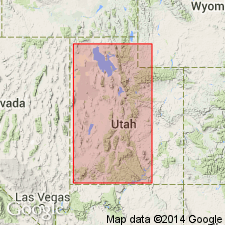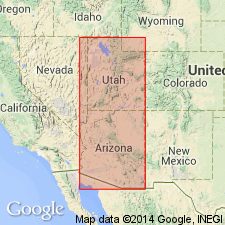
- Usage in publication:
-
- Seligman Limestone
- Modifications:
-
- Revised
- AAPG geologic province:
-
- Paradox basin
Summary:
Dolomite unconformably above the White Rim Sandstone in UT in the Capitol Reef area and unconformably above the Cedar Mesa Sandstone in the San Rafael area formerly assigned to the Kaibab Limestone is removed from the Kaibab and reassigned to the newly named Black Box Dolomite. Term Kaibab is restricted geographically to two areas of southwest UT discussed in this report--Marysvale and Beaver Dam. Kaibab considered to be of group rank in this report and is divided into: 1) Toroweap Formation (basal unit) and Fossil Mountain Limestone (top) at Marysvale; and 2) Seligman (base) and Brady Canyon Limestones, Woods Ranch Formation, and Kaibab Limestone ["when a unit is divided into two or more of the same rank as the original, the original name should not be used for any of the divisions." NASC, 1983, art. 19g.], and Plympton Formation (top) in the Beaver Dam Mountains. Black Box shown as equivalent to Kaibab of the Beaver Dam Mountains. Cross section. Permian age. [Intent or reason to modify rank of Kaibab not stated.]
Source: GNU records (USGS DDS-6; Denver GNULEX).

- Usage in publication:
-
- Seligman Member*
- Modifications:
-
- Revised
- Areal extent
- Reference
- Dominant lithology:
-
- Sandstone
- Siltstone
- Gypsum
- AAPG geologic province:
-
- Basin-and-Range province
- Plateau sedimentary province
Summary:
Designated basal member of Toroweap Formation. Type locality at Aubrey Cliffs, northwest of Seligman, Coconino Co, AZ, Plateau sedimentary province where 22 ft thick member consists of slope-forming, red, calcareous, fine-grained, soft and slope-forming to hard and ledge-forming sandstone. Type locality same section measured by McKee (1938) called gamma member of Toroweap. Part of Seligman limestone of Keyes (1922) and designated member of Toroweap by Sorauf in 1962 unpublished thesis. Reference section from southwest corner sec 12, T33N, R9W to top of Hurricane Cliffs, Whitmore Point 7.5 quad, Mohave Co, AZ, Plateau sedimentary province, where member: 55.8 ft thick; unconformably overlies cliff-forming Coconino Sandstone; underlies cliff-forming Brady Canyon Member (named) of Toroweap; consists of interbedded tan, brown to gray (weathers gray) sandstone, gray, fine-grained limestone, brown, pink gypsiferous siltstone, white, granular to medium-grained, massive gypsum, black, fine-grained, crystalline dolomite, and poorly sorted conglomerate of pebbles as much as 3 in in diameter in sandstone matrix. At reference section: ranges very fine to fine grained, poorly to well sorted, calcareous, ledge forming; gypsum predominant lithology. Recognized as far east as north-south line from Page to Prescott, AZ, Basin-and-Range province. Grades into undivided Toroweap east of that line. Early Permian, Leonardian age. Nomenclature chart.
Source: GNU records (USGS DDS-6; Denver GNULEX).
For more information, please contact Nancy Stamm, Geologic Names Committee Secretary.
Asterisk (*) indicates published by U.S. Geological Survey authors.
"No current usage" (†) implies that a name has been abandoned or has fallen into disuse. Former usage and, if known, replacement name given in parentheses ( ).
Slash (/) indicates name conflicts with nomenclatural guidelines (CSN, 1933; ACSN, 1961, 1970; NACSN, 1983, 2005, 2021). May be explained within brackets ([ ]).

